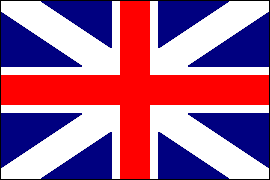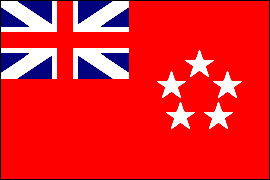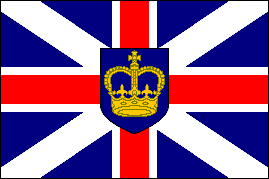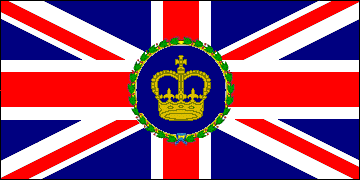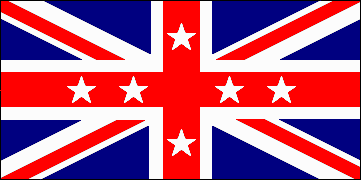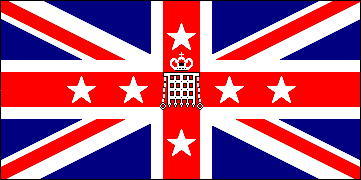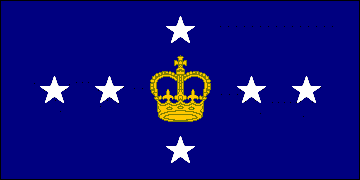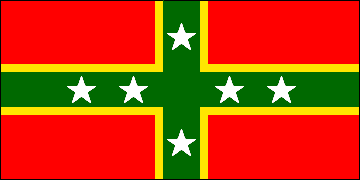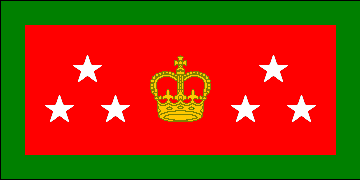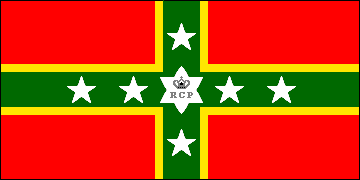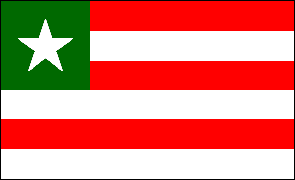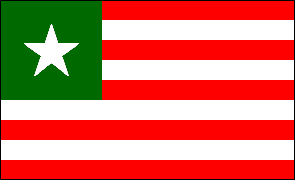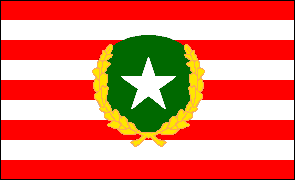|
|
|
|
Robert Sobel's celebrated venture into alternate history postulated a British victory at the Battle of Saratoga (1777) and the subsequent collapse of the American bid for independence. Instead the colonies were reorganized into a Confederation of North America with substantial autonomy. Somewhat like Canada in reality, the CNA gradually developed into a fully independent nation while retaining its link to the Crown. Meanwhile, disaffected partisans of the lost Patriot cause quit British North America and trekked west, eventually to settle in the region we know as Texas and that they named Jefferson. This remote settlement became the kernel of another great nation: the United States of Mexico (Estados Unidos de Mexico). For Want of a Nail chronicles the birth and development of the CNA and the USM and the long-running conflict between them. Images Added August 2022
Naval Ensigns & Flags of the USM (Separate
Page) |
|
|
Sobel neglects to describe the flags of the CNA and the USM, though the dust jacket of a recent edition of the book shows the Continental Colors or Grand Union Flag as the CNA flag. This assumption, however, seems dubious. First, the Grand Union Flag was a flag of rebellion under which the rebels had fought the forces of the Crown. Second, its design (thirteen red and white stripes with the Union Flag as a canton) did not correspond to the political organization of the CNA. Under its founding charter, the Britannic Design, the CNA consisted of five confederations. The Thirteen Colonies constituted the Northern and Southern Confederations; the other three were Quebec, Indiana (roughly, the Northwest Territory of our history) and Manitoba (real-world Canada excluding Quebec and British Columbia). I postulate that the initial national flag of the CNA was simply the pre-1801 Union Flag and that its first distinctive flag was a variant of the British Red Ensign with a circle of five white stars symbolizing the five confederations: a civil ensign for the use of merchant ships registered in the CNA. (When Spanish Louisiana was annexed and organized as the Confederation of Vandalia, a sixth star was added.) For the Viceroy of the CNA, a Union Flag defaced with a shield bearing a royal crown was introduced. After 1800 these flags incorporated the current version of the Union Flag. At that time, the Viceroy's flag was modified to display the crown within a garland, and this pattern was eventually became standard for viceregal flags of British colonies and self-governing dominions. Only in 1842, when the Britannic Design was amended and the CNA became fully independent, did the country acquire a distinctive national flag: the Union Flag with six white stars. The office of Viceroy was retained as the Crown's representative but the chief executive officer and head of government was now the Governor-General. The former's flag remained unchanged and a new one was introduced for the latter: dark blue with six white stars surrounding a royal crown. Between 1877, when Vandalia was partitioned to form the new states of Northern and Southern Vandalia, and 1889, when Quebec became an associated rather than a constituent state of the CNA, the national flag and governor-general's flags bore a seventh star. But since it was stipulated that existing stocks of the six-star versions were to be used up, the seven-star versions were seldom seen. Both flags officially reverted to six stars in 1889. With the passage of time, sentiment grew in favor of a "pure" national flag, free of associations with the colonial past. In 1905 the government invited proposals for such a flag and in 1906 the design selected by a joint legislative committee was officially adopted. Green and gold (yellow) had long been the CNA's unofficial colors; red recalled the country's first distinctive flag, the 1782 civil ensign. The Governor-General's flag was also changed to incorporate the new national colors. For government departments and authorities a badge could be added to both the 1842 and 1906 flags. Usually this was placed at the intersection of the cross.
Initially the British White Ensign
and the Union Jack were used as the CNA naval ensign and jack
respectively. When the 1842 national flag was adopted, it was also
made the naval ensign and a Red Ensign with six stars in the fly
became the naval jack. With the adoption of a new national flag in
1906, a distinctive naval ensign was adopted and the national flag
was specified as the naval jack. See here
for other naval flags of the CNA. |
|
|
CONFEDERATION OF NORTH AMERICA |
CNA
CIVIL ENSIGN •
1782-1801 |
|
CNA VICEREGAL FLAG • 1782-1801 |
CNA VICEREGAL FLAG SINCE 1801 |
|
CNA NATIONAL FLAG & NAVAL ENSIGN • 1842-1906 |
ROYAL CONFEDERATION CUSTOMS FLAG & ENSIGN • 1842-1906 |
|
CNA GOVERNOR-GENERAL'S FLAG • 1842-1906 |
|
|
CNA NATIONAL FLAG & NAVAL JACK SINCE 1906 |
CNA GOVERNOR-GENERAL'S FLAG SINCE 1906 |
|
ROYAL CONFEDERATION POLICE • SERVICE FLAG SINCE 1906 |
|
|
THE UNITED STATES OF MEXICO For the flags of the USM I've postulated as follows. In its early years Jefferson had no formal national flag. Technically the state was a territory of the Spanish crown, though various flags of the American Rebellion were unofficially flown. The Constitution of 1793, however, made provision for a flag and the design chosen was based on the short-lived flag of the United States of America that had been adopted by the Continental Congress in 1777. The colors red, white and blue were retained, with blue at the hoist and three horizontal stripes of red, white and red. On the vertical blue hoist stripe was placed a single white star. The white star on blue was said to symbolized the Constitution's status as the supreme law of the land, while the three horizontal stripes symbolized the executive, legislative and judicial branches of the government. When Jefferson became a constituent state of the United States of Mexico, the Star and Bars as it was nicknamed became a subnational state flag. The flag
adopted in 1820 for the USM was again based on the flag of the
defunct United States of America. The green canton with white star
symbolized the unity of the country and the six stripes of red and
white symbolized the new nation's six constituent states. During the
Mexican Civil War the army of the former Republic of Mexico,
controlled by the secular Federalist Party, had worn green uniforms
with red facings, while the flags of the rebel Clerical Party were
predominantly white. These colors were incorporated into the USM
flag as a symbol of reconciliation. Despite the political
vicissitudes of the USM, the 1820 national flag was not changed
until 1923. In that year Alaska and Hawaii were
incorporated into the USM to make a total of eight states. The
revised national flag was initially to have eight stripes, four red
and four white, but a ninth red stripe was added to balance the
design. This additional stripe was justified by the need to symbolize
the various non-state territories of the USM, such as Martinique and
the Mexican Virgin Islands in the West Indies. A new
presidential flag was adopted at the same time, displaying the emblem
of the Office of the President of the USM on a field of nine
stripes. The 1820 and 1923 national flags also served as naval
ensigns. See here for other naval flags
of the USM. |
|
|
STATE OF JEFFERSON • NATIONAL FLAG • 1793-1820 |
USM NATIONAL FLAG & NAVAL ENSIGN • 1820-1923 |
|
UNITED STATES OF MEXICO •
NATIONAL FLAG SINCE 1923 |
UNITED STATES OF MEXICO •
PRESIDENTIAL FLAG SINCE 1923 |

